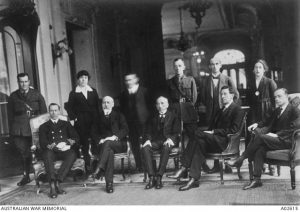- Author
- Swinden, Greg
- Subjects
- Biographies and personal histories, History - WW1
- Tags
-
- RAN Ships
- None noted.
- Publication
- September 2015 edition of the Naval Historical Review (all rights reserved)
By Greg Swinden
During a recent visit to Melbourne, and a tour of the Melbourne Cricket Ground, I noticed the name of 4th Class Naval Staff Clerk Royal Aloysius Patrick Mungovan on the Roll of Honour for members of the Melbourne Cricket Club, who died on active service during the First World War.
Noting all the other names listed were of soldiers other than Commander William Henry Farrington Warren, DSO, RAN who commanded the RAN Destroyer Flotilla in the Mediterranean in 1917-18, it seemed odd for a Naval Staff Clerk to be listed as having lost his life during the war.
A quick piece of research revealed that Royal ‘Roy’ Mungovan was a member of the small Australian delegation to the Imperial War Conference in 1918 and the Versailles Peace Conference in 1919. The delegation was led by Prime Minister William (Billy) Hughes assisted by the Minister of State for the Navy Sir Joseph Cook.
‘Roy’ Mungovan, who normally worked in Navy Office in Melbourne, was appointed as private secretary to Sir Joseph Cook for the period of the delegations activities leading up to the signing of the Treaty of Versailles on 28 June 1919 which effectively brought the war to an end.
The delegation returned embarking in the troopship HMAT Friedrichsruh (1) with repatriating Australian servicemen. She sailed from Devonport, England on 9 July 1919 with the official party departing in Sydney on 4 September 1919 after an absence of 16 months. Unfortunately ‘Roy’ Mungovan died on 13 July 1919, most likely from Pneumonic Influenza then sweeping western Europe, and was buried at sea near the Canary Islands.

Australia), Miss Wood (typist) and Lieutenant Percival Edgar Deane (private secretary to Mr Hughes)
As a civilian member of the RAN he is not entitled to have his name recorded on the Roll of Honour at the Australian War Memorial or on the Commonwealth War Graves Commission Naval Memorial to the Missing at Plymouth. But the Melbourne Cricket Club has not forgotten him.
- HMAT Friedrichsruhwas an handsome passenger/cargo liner originally named Fuerst Bismarckof the Hamburg-Amerika Line. Her name was changed in 1914 and in 1919 she was surrendered to Britain as part of war reparations and later transferred to the Commonwealth.
Notes:
1 Royal Aloysius Patrick Mungovan was born at Sandhurst, Victoria on 22 February 1888 the son of Patrick and Annie Mungovan (nee Craig) who married in 1882. He joined the Commonwealth Naval Forces as a Naval Staff Clerk on 17 April 1905.
2 The Australian Delegation to the Imperial War Conference departed Australia in April 1918. The delegation then remained to take part in the Paris Peace Conference which started on 18 January 1919. The conference finished in January 1920 but the Australian delegation did not stay beyond the signing of the Treaty of Versailles.
3 Royal Mungovan’s siblings were Ulric Basil Mungovan (1890-1928) who served in the 1st AIF as Driver (2750) Mungovan (Australian Army Service Corps) 1 October 1914 – 5 December 1915 (discharged in England in order to join the British Army). Served as a 2ndLieutenant in the Royal Field Artillery until cashiered on 23 June 1916 and sentenced to one year’s prison with hard labour. Married in UK (Middlesex) and had two children. Believed to have died at sea en-route to Australia in 1928.
His sister was Lola Mungovan (born 1895) who joined the Department of Navy in 1918 as a typist. Retired in 1959 and awarded the Imperial Service Medal in 1960. Date of death unknown.
The Australian Plenipotentiaries, the Right Honourable William Morris (Billy) Hughes and Sir Joseph Cook and staff at the Peace Conference in Paris 1919. Identified left to right; Lieutenant Frederick William Eggleston (assistant to Sir Robert Garran), Lieutenant Commander John Greig Latham (Naval Staff Officer), Miss Eleanor Maida Carter (typist), the Right Honourable Sir Joseph Cook (Minister for the Navy, Australia), Mr Roy Mungovan (private secretary to Sir Joseph Cook), ‘Billy’ Hughes (Prime Minister of Australia), Captain Henry Somer Gullett (press liaison officer and later first Director of the Australian War Museum), Mr W. E. Corrigan (messenger), Sir Robert Randolf Garran (Solicitor General Australia), Miss Wood (typist) and Lieutenant Percival Edgar Deane (private secretary to Mr Hughes).




